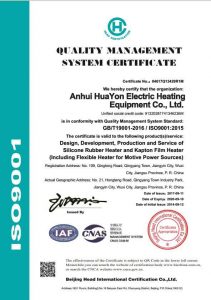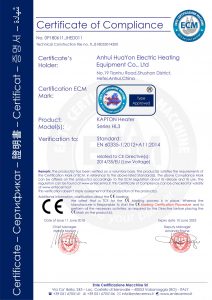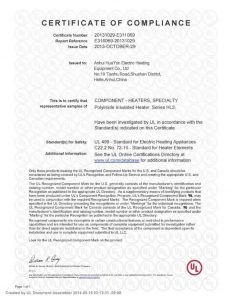Silicone Heating Blanket Quick Detail
Applicable Industries: medicine and healthcare, aerospace and aviation, Automotive industry, Consumer electronics
state: New
Type: electric heater
Birthplace:Anhui, China
brand name: HuaYon customize it
Dimension (L*W*H): personalized
Voltage: 3,7 ~ 480 V
1 one year warranty
Working temperature range: -30~200ºC
Material: Silicone rubber + engraved metal sheet
Thickness: 1,5-3 mm
Back adhesive: 3M 467/468 the personalized
Power density: 0,01-2,5 w/cm²
Power deviation: ±5%
Supply capacity: 50000 units per month
Packaging Details: inner PE bag + card
Certificates: THIS, RoHS, ISO9001
Silicone rubber heater is a type of thin film that heats up when electrified, in a standard thickness of 1.5 mm, Adopting nickel-chromium wires or nickel-chromium foils from 0.05 mm ~ 0.10 mm thick engraved in certain shapes, the heating component is wrapped with heat conductors and insulating materials on both sides, and completed in high temperature die forming and aging heat treatment.
Voltage | 3V-480V | Thickness | 1.5mm-3mm |
Power Density | 0.1-1.2W/CM2 | Insulation Ohm | More than 5MΩ |
Min Size | 10*10mm | Max Temperature | 250 degree |
Max Size | 2000*10000mm | Wire Tension | 15N*15N |
What is silicone rubber heater?
Freeze protection and condensation prevention for many types of instrumentation and equipment.
Medical equipment such as blood analyzers and test tube warmers.
Computer peripherals such as laser printers.
Curing of plastic laminates.
Photo Processing Equipment.
Semiconductor Processing Equipment.
Thermal transfer equipment
Drums and other containers and viscosity control and asphalt storage.
Key features and benefits of silicone rubber heaters include:
Flexibility: The flexibility of silicone rubber allows for molding, bend or mold these heaters to fit various shapes and surfaces. This feature makes them suitable for applications where rigid heaters are not practical..
Uniform heating: These heaters distribute heat evenly across their entire surface., mitigating the appearance of hot spots or cold regions and ensuring constant heating.
Quick response to heating: Silicone rubber heaters are known for their fast response times in reaching and adjusting temperatures., making them suitable for applications requiring rapid heating adjustments.
Durability: silicone rubber is resistant to various environmental factors, like humidity, chemicals and moderate physical wear, which improves the robustness of the heater.
Electrical isolation: The electrical insulating properties of silicone rubber ensure safe use in applications where electrical insulation is vital.
Customizable layout: Manufacturers can customize silicone rubber heaters in terms of size, form, power and temperature distribution to meet specific heating requirements.
Silicone rubber heaters are used in a wide spectrum of industries and applications, including:
Industrial processes: Heat tanks, pipelines, valves and manufacturing equipment, and assist in curing operations, drying and preheating.
Medical devices: They are used in medical equipment as IV bag warmers, heated patient warmers and medical imaging tables.
Aerospace and aviation: preventing ice buildup on aircraft components by deicing critical areas such as wings.
Food and beverage industry: maintenance of specific temperatures in food processing equipment, such as boilers and tanks, during production processes.
electronics: Integration in electronic cabinets, display panels and other devices for temperature regulation.
Automotive section: Used in seat heating applications, defrosting windows and preheating engines in vehicles.
Silicone Heating Blankets: versatile and efficient heating solutions
Silicone heating blankets, also known as silicone rubber heaters, They are flexible heating elements, Thin and versatile that are widely used in various industrial applications, commercial and residential. They are designed to provide efficient and uniform heat over a large surface area, which makes them ideal for temperature maintenance, protection against freezing and heating processes.
Composition and structure
Silicone thermal blankets are made of several layers, each of which fulfills a specific function:
Silicone rubber layers: These layers provide flexibility, durability and resistance to environmental factors such as humidity, chemicals and UV radiation. Silicone rubber is an excellent electrical insulator and can withstand high temperatures without degrading.
heating element: The core of the heating blanket contains a resistive heating element, usually made of nichrome wire (nickel-chromium) or engraved sheet. This element generates heat when an electric current passes through it.
Fiberglass reinforcement: Some silicone heating blankets include a layer of fiberglass for added strength and dimensional stability, ensuring the heater maintains its shape and integrity during use.
Features and Benefits
Silicone heating blankets offer numerous advantages that make them suitable for a wide range of applications.:
Flexibility: The flexible nature of silicone allows these heaters to conform to irregular shapes and surfaces, providing constant heat distribution.
Durability: Silicone rubber is very durable and resistant to physical damage, humidity, chemicals and UV radiation, ensuring long life even in harsh environments.
Efficient heating: Heating elements inside the silicone blankets provide fast, even heat, which reduces energy consumption and improves process efficiency.
Personalization: Silicone heating blankets can be custom designed to fit shapes, specific sizes and power requirements, which makes them versatile for various applications.
Temperature control: These heaters can be equipped with integrated temperature sensors and controllers, allowing precise temperature regulation and preventing overheating.
Applications
Silicone heating blankets are used in a variety of industries and applications, including:
Industrial applications:
Heating of pipes and tanks: Maintain the temperature of fluids and gases in pipes and tanks to avoid freezing or viscosity changes.
Composite curing: Provides uniform heat to cure composite materials in the aerospace industries, automotive and marine.
Drum warm-up: ensure that the content of drums, barrels and containers remain at a constant temperature.
Business applications:
Food service equipment: Keep food warm and prevent spoilage in commercial kitchens and food processing plants.
Laboratory equipment: heating laboratory instruments and samples to precise temperatures for experiments and tests.
Residential applications:
Underfloor heating: Provide underfloor heating in residential and commercial buildings for added comfort.
Home brewing: Maintain optimal fermentation temperatures in home brewing setups.
Installation and security
Installation of silicone heating blankets is usually simple and involves securing the heater to the desired surface using straps, adhesive or integrated mounting options. It is essential to follow the manufacturer's guidelines and safety instructions to ensure proper installation and avoid hazards.
Safety considerations include:
Avoid overheating: use temperature controllers and sensors to prevent the heater from exceeding safe temperature limits.
Electrical safety: Make sure electrical connections and grounding are adequate to avoid electric shock or short circuits..
Surface Compatibility: Check that the surface material is compatible with the heater to avoid damage or reduced efficiency.
![]()
![]()





Reviews
There are no reviews yet.